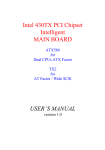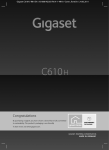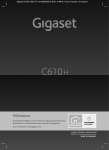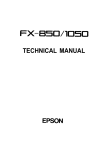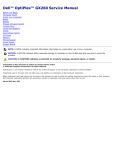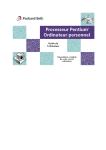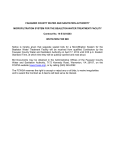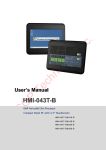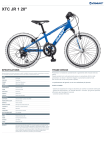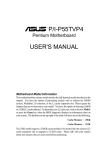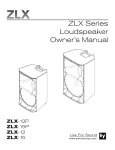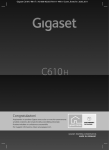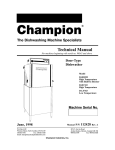Download Service Manual ()
Transcript
'HOO'LPHQVLRQ;360V0VDQG0V6\VWHPV 6(59,&(0$18$/ ® ____________________ Information in this manual is subject to change without notice. 1997 Dell Computer Corporation. All rights reserved. Reproduction in any manner whatsoever without the written permission of Dell Computer Corporation is strictly forbidden. Trademarks used in this text: Dell, the DELL logo, and Dell Dimension are registered trademarks of Dell Computer Corporation; Microsoft, MS-DOS, and Windows are registered trademarks of Microsoft Corporation; Intel and Pentium are registered trademarks and MMX is a trademark of Intel Corporation; IBM is a registered trademark of International Business Machines Corporation. Other trademarks and trade names may be used in this document to refer to either the entities claiming the marks and names or their products. Dell Computer Corporation disclaims any proprietary interest in trademarks and trade names other than its own. December 1997 P/N 84858 Rev. A01 Contents Chapter 1 System Overview. . . . . . . . . . . . . . . . . . . . . . . . . . . . . . . 1-1 System Features . . . . . . . . . . . . . . . . . . . . . . . . . . . . . . . . . . . . . . . . . . . . . . . 1-2 Advanced Expansion Subsystem . . . . . . . . . . . . . . . . . . . . . . . . . . . . . . . 1-6 EIDE Subsystem . . . . . . . . . . . . . . . . . . . . . . . . . . . . . . . . . . . . . . . . . . . . 1-6 Hard-Disk Drive Options . . . . . . . . . . . . . . . . . . . . . . . . . . . . . . . . . . . . . 1-7 System Unit. . . . . . . . . . . . . . . . . . . . . . . . . . . . . . . . . . . . . . . . . . . . . . . . . . . 1-8 Power Supply . . . . . . . . . . . . . . . . . . . . . . . . . . . . . . . . . . . . . . . . . . . . . . 1-8 DC Power Distribution . . . . . . . . . . . . . . . . . . . . . . . . . . . . . . . . . . . . 1-9 DC Power Connector Pin Assignments . . . . . . . . . . . . . . . . . . . . . . 1-11 System Board . . . . . . . . . . . . . . . . . . . . . . . . . . . . . . . . . . . . . . . . . . . . . 1-13 Main Memory . . . . . . . . . . . . . . . . . . . . . . . . . . . . . . . . . . . . . . . . . . 1-13 System Board Jumpers . . . . . . . . . . . . . . . . . . . . . . . . . . . . . . . . . . . 1-14 Interrupt Assignments. . . . . . . . . . . . . . . . . . . . . . . . . . . . . . . . . . . . . . . . . . 1-16 DMA Channel Assignments . . . . . . . . . . . . . . . . . . . . . . . . . . . . . . . . . . . . . 1-17 Technical Specifications . . . . . . . . . . . . . . . . . . . . . . . . . . . . . . . . . . . . . . . . 1-18 Chapter 2 Basic Troubleshooting . . . . . . . . . . . . . . . . . . . . . . . . . . 2-1 Initial User Contact . . . . . . . . . . . . . . . . . . . . . . . . . . . . . . . . . . . . . . . . . . . . . 2-1 External Visual Inspection . . . . . . . . . . . . . . . . . . . . . . . . . . . . . . . . . . . . . . . 2-2 Observing the Boot Routine . . . . . . . . . . . . . . . . . . . . . . . . . . . . . . . . . . . . . . 2-3 Internal Visual Inspection . . . . . . . . . . . . . . . . . . . . . . . . . . . . . . . . . . . . . . . . 2-4 Eliminating Resource Conflicts . . . . . . . . . . . . . . . . . . . . . . . . . . . . . . . . . . . 2-6 Running the Diskette-Based Diagnostics . . . . . . . . . . . . . . . . . . . . . . . . . . . . 2-6 Getting Help . . . . . . . . . . . . . . . . . . . . . . . . . . . . . . . . . . . . . . . . . . . . . . . . . . 2-7 v Chapter 3 Beep Codes and Error Messages . . . . . . . . . . . . . . . . . . 3-1 POST Beep Codes . . . . . . . . . . . . . . . . . . . . . . . . . . . . . . . . . . . . . . . . . . . . . 3-1 System Error Messages . . . . . . . . . . . . . . . . . . . . . . . . . . . . . . . . . . . . . . . . . 3-3 Chapter 4 Removing and Replacing Parts . . . . . . . . . . . . . . . . . . . 4-1 Precautionary Measures . . . . . . . . . . . . . . . . . . . . . . . . . . . . . . . . . . . . . . . . . 4-1 Computer Cover . . . . . . . . . . . . . . . . . . . . . . . . . . . . . . . . . . . . . . . . . . . . . . . 4-2 Front Bezel . . . . . . . . . . . . . . . . . . . . . . . . . . . . . . . . . . . . . . . . . . . . . . . . . . . 4-3 Drives . . . . . . . . . . . . . . . . . . . . . . . . . . . . . . . . . . . . . . . . . . . . . . . . . . . . . . . 4-4 Front-Panel Insert . . . . . . . . . . . . . . . . . . . . . . . . . . . . . . . . . . . . . . . . . . . 4-4 Drive Cage . . . . . . . . . . . . . . . . . . . . . . . . . . . . . . . . . . . . . . . . . . . . . . . . 4-5 5.25-Inch Drive . . . . . . . . . . . . . . . . . . . . . . . . . . . . . . . . . . . . . . . . . . . . 4-6 Upper 3.5-Inch Drive . . . . . . . . . . . . . . . . . . . . . . . . . . . . . . . . . . . . . . . . 4-7 Lower 3.5-Inch Drive . . . . . . . . . . . . . . . . . . . . . . . . . . . . . . . . . . . . . . . . 4-8 3.5-Inch Diskette Drive . . . . . . . . . . . . . . . . . . . . . . . . . . . . . . . . . . . . . . 4-9 Primary Hard-Disk Drive . . . . . . . . . . . . . . . . . . . . . . . . . . . . . . . . . . . . 4-10 Secondary Hard-Disk Drive . . . . . . . . . . . . . . . . . . . . . . . . . . . . . . . . . . 4-11 Power Supply . . . . . . . . . . . . . . . . . . . . . . . . . . . . . . . . . . . . . . . . . . . . . . . . 4-13 Cooling-Fan Assembly. . . . . . . . . . . . . . . . . . . . . . . . . . . . . . . . . . . . . . . . . 4-14 Expansion Cards. . . . . . . . . . . . . . . . . . . . . . . . . . . . . . . . . . . . . . . . . . . . . . 4-15 Card Guide Assembly . . . . . . . . . . . . . . . . . . . . . . . . . . . . . . . . . . . . . . . . . 4-16 Control Panel Board . . . . . . . . . . . . . . . . . . . . . . . . . . . . . . . . . . . . . . . . . . . 4-17 System Board Components . . . . . . . . . . . . . . . . . . . . . . . . . . . . . . . . . . . . . 4-18 DIMMs . . . . . . . . . . . . . . . . . . . . . . . . . . . . . . . . . . . . . . . . . . . . . . . . . . 4-19 Cache Card . . . . . . . . . . . . . . . . . . . . . . . . . . . . . . . . . . . . . . . . . . . . . . . 4-20 Microprocessor/Heat Sink Assembly. . . . . . . . . . . . . . . . . . . . . . . . . . . 4-21 Battery . . . . . . . . . . . . . . . . . . . . . . . . . . . . . . . . . . . . . . . . . . . . . . . . . . 4-23 System Board . . . . . . . . . . . . . . . . . . . . . . . . . . . . . . . . . . . . . . . . . . . . . . . . 4-24 Appendix A System Setup Program . . . . . . . . . . . . . . . . . . . . . . . . . . A-1 System Setup Screens. . . . . . . . . . . . . . . . . . . . . . . . . . . . . . . . . . . . . . . . . . . A-2 Index vi Figures Figure 1-1. Figure 1-2. Figure 1-3. Figure 1-4. Figure 1-5. Figure 1-6. Figure 1-7. Figure 1-8. Figure 1-9. Figure 1-10. Figure 1-11. Figure 1-12. Figure 4-1. Figure 4-2. Figure 4-3. Figure 4-4. Figure 4-5. Figure 4-6. Figure 4-7. Figure 4-8. Figure 4-9. Figure 4-10. Figure 4-11. Figure 4-12. Figure 4-13. Figure 4-14. Figure 4-15. Figure 4-16. Figure 4-17. Figure 4-18. Figure 4-19. Figure 4-20. Figure 4-21. Figure 4-22. Figure 4-23. Figure 4-24. Figure 4-25. Computer Orientation . . . . . . . . . . . . . . . . . . . . . . . . . . . . . . . 1-3 Desktop Computer Front-Panel Features (Europe Only). . . . . 1-3 Internal View of the Desktop Computer . . . . . . . . . . . . . . . . . 1-4 Mini Tower Computer Front-Panel Features . . . . . . . . . . . . . . 1-4 Internal View of the Mini Tower Computer . . . . . . . . . . . . . . 1-5 Desktop and Mini Tower Computer Back-Panel Features . . . 1-5 DC Power Cables . . . . . . . . . . . . . . . . . . . . . . . . . . . . . . . . . . . 1-9 DC Power Distribution. . . . . . . . . . . . . . . . . . . . . . . . . . . . . . 1-10 DC Power Connector P1 . . . . . . . . . . . . . . . . . . . . . . . . . . . . 1-11 DC Power Connectors P2, P3, P4, P5, P6, and P7. . . . . . . . . 1-12 System Board Features. . . . . . . . . . . . . . . . . . . . . . . . . . . . . . 1-13 System Board Jumpers. . . . . . . . . . . . . . . . . . . . . . . . . . . . . . 1-14 Computer Cover Removal . . . . . . . . . . . . . . . . . . . . . . . . . . . . 4-2 Front-Bezel Removal (Mini Tower Chassis) . . . . . . . . . . . . . . 4-3 Front-Bezel Removal (Desktop Chassis, Europe Only) . . . . . 4-3 Front-Panel Insert Removal . . . . . . . . . . . . . . . . . . . . . . . . . . . 4-4 Drive Cage Removal . . . . . . . . . . . . . . . . . . . . . . . . . . . . . . . . 4-5 5.25-Inch Drive Removal. . . . . . . . . . . . . . . . . . . . . . . . . . . . . 4-6 Upper 3.5-Inch Drive Removal . . . . . . . . . . . . . . . . . . . . . . . . 4-7 Lower 3.5-Inch Drive Removal . . . . . . . . . . . . . . . . . . . . . . . . 4-8 3.5-Inch Diskette Drive Removal . . . . . . . . . . . . . . . . . . . . . . 4-9 Primary Hard-Disk Drive Removal . . . . . . . . . . . . . . . . . . . . 4-10 Secondary Hard-Disk Drive Assembly Removal . . . . . . . . . 4-11 Secondary Hard-Disk Drive Removal . . . . . . . . . . . . . . . . . . 4-12 Power Supply Removal . . . . . . . . . . . . . . . . . . . . . . . . . . . . . 4-13 Cooling-Fan Assembly Removal . . . . . . . . . . . . . . . . . . . . . . 4-14 Expansion Card Removal. . . . . . . . . . . . . . . . . . . . . . . . . . . . 4-15 Card Guide Assembly Removal. . . . . . . . . . . . . . . . . . . . . . . 4-16 Control Panel Board Removal . . . . . . . . . . . . . . . . . . . . . . . . 4-17 System Board Components . . . . . . . . . . . . . . . . . . . . . . . . . . 4-18 DIMM Removal . . . . . . . . . . . . . . . . . . . . . . . . . . . . . . . . . . . 4-19 DIMM Replacement . . . . . . . . . . . . . . . . . . . . . . . . . . . . . . . 4-19 Cache Card Removal . . . . . . . . . . . . . . . . . . . . . . . . . . . . . . . 4-20 Microprocessor/Heat Sink Assembly Removal . . . . . . . . . . . 4-21 Battery Removal . . . . . . . . . . . . . . . . . . . . . . . . . . . . . . . . . . 4-23 System Board Removal . . . . . . . . . . . . . . . . . . . . . . . . . . . . . 4-24 System Board Mountings (Five Screws) . . . . . . . . . . . . . . . . 4-25 vii Figure 4-26. System Board Mountings (Hooked Standoffs) . . . . . . . . . . . 4-25 Figure 4-27. Mounting Screw and Bracket (Systems With Hooked Standoffs) . . . . . . . . . . . . . . . . . . . . 4-26 Figure 4-28. Bracket Removal (Systems With Hooked Standoffs) . . . . . . 4-26 Figure A-1. System Setup Screens . . . . . . . . . . . . . . . . . . . . . . . . . . . . . . . A-2 Tables Table 1-1. Table 1-2. Table 1-3. Table 1-4. Table 1-5. Table 3-1. Table 3-2. Table A-1. viii DC Voltage Ranges . . . . . . . . . . . . . . . . . . . . . . . . . . . . . . . . . 1-8 System Board Jumper Descriptions. . . . . . . . . . . . . . . . . . . . 1-15 Interrupt Assignments . . . . . . . . . . . . . . . . . . . . . . . . . . . . . . 1-16 DMA Channel Assignments . . . . . . . . . . . . . . . . . . . . . . . . . 1-17 Technical Specifications . . . . . . . . . . . . . . . . . . . . . . . . . . . . 1-18 POST Beep Codes . . . . . . . . . . . . . . . . . . . . . . . . . . . . . . . . . . 3-2 System Error Messages . . . . . . . . . . . . . . . . . . . . . . . . . . . . . . 3-3 System Setup Categories . . . . . . . . . . . . . . . . . . . . . . . . . . . . . A-3 ix Read This First A prerequisite for using this manual to service Dell computer systems is a basic knowledge of IBM®-compatible PCs and prior training in IBMcompatible PC troubleshooting techniques. In addition to information provided in this manual and the online System User’s Guide that came with the system, Dell provides the Diagnostics and Troubleshooting Guide for troubleshooting procedures and instructions on using the Dell diagnostics to test the computer system. Warnings, Cautions, and Notes Throughout this manual, there may be blocks of text printed in bold type or in italic type. These blocks are warnings, cautions, and notes, and they are used as follows: WARNING: A WARNING indicates the potential for bodily harm and provides instructions for how to avoid the problem. CAUTION: A CAUTION indicates either potential damage to hardware or loss of data and provides instructions for how to avoid the problem. NOTE: A NOTE provides helpful information about using the computer system. x Chapter 1 System Overview The Dell Dimension ® XPS M166s, M200s, and M233s systems are high-speed, single-processor computer systems that use the Intel® Pentium® microprocessor with MMX™ technology and Intel 430VX PCIset. NOTE: The Dell Dimension XPS M166s, M200s, and M233s systems do not support the use of Pentium microprocessors without MMX technology. These Dell® systems incorporate an ISA expansion bus as well as a highperformance PCI local bus. These buses are built into the system board, which also integrates the Pentium microprocessor with MMX technology and all other elements of the basic computer system. The microprocessor in the Dell Dimension XPS M166s system operates at an internal frequency of 166 MHz and an external frequency of 66 MHz. The Dell Dimension XPS M200s system operates at an internal frequency of 200 MHz and an external frequency of 66 MHz. The Dell Dimension XPS M233s system operates at an internal frequency of 233 MHz and an external frequency of 66 MHz. These microprocessors are installed in a ZIF socket to allow future upgrades when more powerful microprocessors become available. The system’s main memory uses one or two DIMMs in sockets on the system board. Synchronous dynamic random-access memory (SDRAM) DIMMs are supported. The front of the computer has two 5.25-inch drive bays, one (desktop systems) or two (mini tower systems) 3.5-inch drive bay(s), plus a 3.5-inch diskette-drive bay. The 5.25-inch and 3.5-inch drive bays can hold diskette drives, tape drives, or CD-ROM drives. System Overview 1-1 System Features In addition to the standard features found in a traditional PC, the Dell Dimension XPS M166s, M200s, and M233s systems include the following new and/or advanced features: • Intel Pentium microprocessor with MMX technology, specifically designed to handle complex multimedia and communications software. • • • • • External cache with 512 KB of single-bank pipelined burst SRAM. Math coprocessor functionality internal to the Pentium microprocessor. An ISA and PCI expansion subsystem connected to the PCI bus. Full Plug and Play capability. Two high-performance EIDE interfaces that each support up to two devices, for a total of four EIDE devices. Of these four EIDE devices, up to two can be 1-inch-high internal EIDE hard-disk drives. • Memory that can be expanded up to 64 MB using SDRAM DIMMs. SDRAM DIMMs are available in capacities of 16 and 32 MB. • A high-speed, high-resolution PCI video controller card installed in an expansion-card slot, rather than an integrated video controller, to provide video flexibility for customers. • Support for SCSI hard-disk drives, tape drives, and CD-ROM drives when a SCSI controller is installed in an expansion-card slot. • • • • An integrated high-performance serial port. An integrated bidirectional parallel port. Two USB ports, which can simplify connecting peripheral devices. A 16-bit integrated audio controller that provides sound functions found on the Sound Blaster Vibra 16 expansion card. • A MIDI/game port for connecting a MIDI device, joystick, game pad, or other game input device. Most of these features are briefly described in this chapter. For a complete list of system features, see “Technical Specifications” found later in this chapter. 1-2 Dell Dimension XPS M166s, M200s, and M233s Systems Service Manual When following the descriptions in this manual, assume that the locations or directions relative to the computer are as shown in Figure 1-1. NOTE: Some service procedures recommend laying the mini tower computer on its right side to improve service access, but the descriptions continue to use the directions shown for mini tower computers in Figure 1-1. back back left side left side right side right side front front Mini Tower Computers Desktop Computers Figure 1-1. Computer Orientation 3.5-inch diskette drive 5.25-inch drive bays (2) 3.5-inch drive bay power button reset button hard-disk drive access indicator Figure 1-2. Desktop Computer Front-Panel Features (Europe Only) System Overview 1-3 power supply cooling fan secondary hard-disk drive bracket system board drive cage filler brackets drive bays (typical) card guide assembly and primary hard-disk drive 3.5-inch diskette drive power button hard-disk drive access indicator reset button front bezel Figure 1-3. Internal View of the Desktop Computer 5.25-inch drive bays (2) 3.5-inch drive bays (2) 3.5-inch diskette drive power button hard-disk drive access indicator reset button Figure 1-4. Mini Tower Computer Front-Panel Features 1-4 Dell Dimension XPS M166s, M200s, and M233s Systems Service Manual cooling fan power supply secondary hard-disk drive bracket system board filler brackets drive cage drive bays (typical) 3.5-inch diskette drive card guide assembly and primary hard-disk drive power button reset button front bezel hard-disk drive access indicator Figure 1-5. Internal View of the Mini Tower Computer parallel port connector MIDI/game port connector video connector voltage selection switch AC power receptacle mouse connector keyboard connector serial port connector USB connectors (2) microphone port connector line-in port connector line-out port connector Figure 1-6. Desktop and Mini Tower Computer Back-Panel Features System Overview 1-5 CAUTION: To avoid possible data or file structure corruptions, the reset button should only be used when the system cannot be rebooted by pressing <Ctrl><Alt><Delete>. Before you use the reset button to initiate a hardware reset, close any open application programs and files if possible. CAUTION: Ensure that all expansion-card slots have either a cardmounting bracket or a metal filler bracket installed. Omitting these brackets can disturb the normal airflow in the computer, resulting in possible damage to system components. Advanced Expansion Subsystem This computer offers an advanced expansion subsystem that can support a mixture of traditional ISA expansion cards (called legacy expansion cards), Plug and Play ISA expansion cards, and PCI expansion cards. The Microsoft® Windows® 95 operating system provides the means to configure the various types of expansion cards and avoid resource conflicts that might arise. After all legacy expansion cards have been configured by the operating system, the system automatically assigns any required memory space, IRQ lines, and DREQ lines to any installed Plug and Play expansion cards and PCI expansion cards the next time the system is booted. The expansion-card slots include three ISA expansion-card connectors and four PCI expansion-card connectors. One PCI expansion-card connector and one ISA expansion-card connector share a single expansion-card slot, so a maximum of six expansion cards can be installed. EIDE Subsystem The EIDE subsystem includes two EIDE interfaces (primary and secondary), each of which can support up to two EIDE devices such as high-capacity EIDE hard-disk drives, CD-ROM drives, and tape drives. When an EIDE tape drive or CD-ROM drive is connected to the same interface connector as a hard-disk drive, the performance of the hard-disk drive is degraded. Therefore, the primary EIDE interface should be used for connecting hard-disk drives only. Any EIDE tape drives or CD-ROM drives should be connected to the secondary EIDE interface. When two EIDE drives are connected to a single EIDE interface cable, a master/slave relationship between the two drives must be defined so that they will operate correctly. 1-6 Dell Dimension XPS M166s, M200s, and M233s Systems Service Manual Assigning the master and slave designations usually involves resetting jumpers on the circuit card on the underside of each drive. The master/slave relationship is defined in different ways for different types of drives. For details about your specific drive, refer to the documentation included with the drive. When you replace a drive, look at the jumpers on the removed drive to set the jumpers on the replacement drive. NOTE: The externally accessible drive bays at the front of the computer are normally used for diskette drives, CD-ROM drives, or tape drives. Hard-disk drives should be installed in the internal drive bays described in the next subsection, “Hard-Disk Drive Options.” For detailed information about the data storage subsystem, see Chapter 5, “Installing Drives,” in the Reference Guide. Hard-Disk Drive Options A 1-inch-high EIDE hard-disk drive is installed in the primary hard-disk drive bay in the card guide assembly at the front of the chassis. An optional 1-inchhigh EIDE hard-disk drive can be installed in the secondary hard-disk drive bay located to the left of the 3.5-inch diskette drive (desktop) or below the 3.5-inch diskette drive (mini tower). For best results, any installed hard-disk drives should be connected to the primary EIDE interface and any other EIDE devices should be connected to the secondary EIDE interface. System Overview 1-7 System Unit The following subsections provide service-related information about the system unit. Power Supply The 200-W power supply can operate from an AC power source of 115 VAC at 60 Hz or 230 VAC at 50 Hz. The power supply provides the DC operating voltages and currents listed in Table 1-1. NOTE: The power supply produces DC voltages only under its loaded condition. The DC power cable connectors must be connected to their corresponding power input connectors on the system board or drives in order to measure these voltages. Table 1-1. DC Voltage Ranges 1-8 Voltage Range Maximum Output Current +3.3 VDC +3.14 to +3.47 VDC 14.00 A1 +5 VDC +4.90 to +5.25 VDC 22.00 A1 –5 VDC –4.50 to –5.50 VDC 0.300 A +12 VDC +11.40 to +12.60 VDC 6.00 A2 –12 VDC –10.80 to –13.20 VDC 0.300 A +5 VSB3 +4.75 to +5.25 VDC 0.010 A 1 The +3.3 VDC and +5 VDC outputs are limited to a maximum combined power of 140 W. 2 The +12-VDC output line can withstand surges of up to 11.0 A to support disk start-up operations. 3 The +5 VSB (volts standby) is sometimes called “flea power.” Dell Dimension XPS M166s, M200s, and M233s Systems Service Manual DC Power Distribution Figures 1-7 through 1-10 provide the following information about DC power distribution: • Power-supply cable identification • Typical DC power connections for diskette, tape, CD-ROM, and hard-disk drives • Pin assignments of DC power connectors • Power distribution to sockets and connectors on the system board P1 P4 P5 P7 P6 P3 P2 Figure 1-7. DC Power Cables System Overview 1-9 5.25-inch drive P2 3.3 VDC GND 5.25-inch drive PWRGOOD +12 VDC power supply P3 +5 VDC 3.5-inch drives (second drive uses Y-cable) –5 VDC +5 VDC P5 GND +5 VSB 3.5-inch diskette drive PSON# P4 primary hard-disk drive power switch secondary hard-disk drive (uses Y-cable) P6 P7 P1 J9E1 POWER 3.3 VDC battery PSON# RTC GND GND +5 VSB COAST +3.3 VDC +5 VDC J1A1 J1A2 J1B1 GND GND +5 VDC –5 VDC +5 VDC BANK0 J2C1 J2D1 J2E1 J2E2 –12 VDC GND +12 VDC +5 VDC BANK1 GND fuse GND +5 VDC KEYBD GND +5 VDC 2.8-VDC converter fuse GND +5 VDC CPU/system logic +2.8 VDC system board Figure 1-8. DC Power Distribution 1-10 Dell Dimension XPS M166s, M200s, and M233s Systems Service Manual USB0 USB1 GND +12 VDC GND MSE J7M1 DC Power Connector Pin Assignments The power-supply output voltages can be measured at the back (wire side) of the DC power connectors without disconnecting the connectors. Figures 1-9 and 1-10 show the wire side of the connectors. –5 VDC (white) +5 VDC (red) common (black) +5 VDC (red) common (black) +5 VDC (red) not connected common (black) PSON# 2 (brown) +5 VDC (red) 11 12 13 14 15 16 17 18 19 20 P1 1 2 3 4 5 6 +5 VDC (red) common (black) +5 VDC (red) common (black) PWRGOOD 1 (grey) 7 8 9 10 common (black) common (black) –12 VDC (blue) +12 VDC (yellow) +5 VFP (purple) 1 Pin 5 — PWRGOOD is a status signal generated by the power supply to notify the system that the DC operating voltages are within the ranges required for proper system operation. 2 Pin 11 — PSON# is activated by pressing and releasing the power button while the power supply is in its standby state. This action connects the power supply’s PSON# input to ground, thereby switching the power supply to its full-on condition. Figure 1-9. DC Power Connector P1 System Overview 1-11 P2, P3, P5, P6 1 2 3 P4 1 2 3 4 +5 VDC (red) 4 +5 VDC (red) common (black) common (black) common (black) common (black) +12 VDC (yellow) +12 VDC (yellow) P7 1 2 3 4 5 6 +3.3 VDC (orange) +3.3 VDC (orange) +3.3 VDC (orange) common (black) common (black) common (black) Figure 1-10. DC Power Connectors P2, P3, P4, P5, P6, and P7 1-12 Dell Dimension XPS M166s, M200s, and M233s Systems Service Manual System Board The subsections that follow provide service-related information about system board components. NOTE: The cache card connector (COAST) appears only on early versions of the system board. Later versions have the cache memory chips soldered directly on the system board. keyboard connector (KEYBD) microprocessor socket (U3L1) cache card socket (COAST) mouse connector (MSE) USB connectors (USB0 and USB1) serial port connector (COM1) power input connector (POWER) microprocessor fan connector (J7M1) battery socket (BH9L1) 3.3-V power input connector (3.3V) primary EIDE channel connector (PRI IDE) parallel port connector (PARALLEL) diskette-drive interface connector (FLOPPY) integrated audio controller jacks (LINE OUT, LINE IN, and MIC) below, MIDI/game port (GAME) above secondary EIDE channel connector (SEC IDE) CD-ROM drive audio cable connector (CD) wave-table expansion card connector (WAVE) ISA expansion-card connectors (J1A1, J1A2, and J1B1) DIMM sockets (BANK0 and BANK1) control panel connector (J9E1) SCSI hard-disk drive access indicator cable connector (HDLED), cable attaches to pins 1–4 on header system board jumpers PCI expansion-card connectors (J2C1, J2D1, J2E1, and J2E2) Figure 1-11. System Board Features Main Memory The two DIMM sockets (BANK0 and BANK1) accommodate SDRAM DIMMs. Memory can be expanded up to 64 MB. Unlike SIMMs, which must be added in matched pairs, DIMMs may be added individually or in pairs. SDRAM DIMMs improve the performance of the computer’s memory subsystem by reducing the need for wait states. SDRAM devices have a synchronous interface to the devices to which they are connected and are governed by the system clock. These features reduce wait states, which are often required for conventional memory devices to ensure that timing signals have been set up correctly. System Overview 1-13 System Board Jumpers jumpered unjumpered Figure 1-12. System Board Jumpers 1-14 Dell Dimension XPS M166s, M200s, and M233s Systems Service Manual Table 1-2. System Board Jumper Descriptions Jumper Description Settings A, pins 1–3 (password) Enables or disables the password features; allows clearing of the system and setup passwords Set to pins 2–3; then turn on the system to clear the password(s). Clears NVRAM and causes CMOS settings to revert to their default values at system startup Set to pins 5–6; then turn on the system to clear NVRAM. Enables or disables access to the system setup program Set to pins 2–3 to prevent loading the system setup program. A, pins 4–6 (clear CMOS) B, pins 1–3 (setup) Turn off power and set the jumper back to pins 1–2 to enable the password features. Turn off power and set the jumper back to pins 4–5 to restore default CMOS settings upon start-up. Set to pins 1–2 to allow use of the system setup program. B, pins 4–6 Reserved No jumper installed. C, D (microprocessor speed) Controls the microprocessor’s internal speed 166 MHz = Pins 1–2 and 5–6 on jumper C, and pins 2–3 and 5–6 on jumper D. 200 MHz = Pins 1–2 and 5–6 on jumper C, and pins 1–2 and 5–6 on jumper D. 233 MHz = Pins 1–2 and 5–6 on jumper C, and pins 1–2 and 4–5 on jumper D. System Overview 1-15 Interrupt Assignments Table 1-3. Interrupt Assignments 1-16 IRQ Line Used By/Available IRQ0 Generated by system timer. IRQ1 Generated by I/O controller to indicate full keyboard output buffer. IRQ2 Generated internally by interrupt controller to enable IRQ8 through IRQ15. IRQ3 Available for use by an expansion card. IRQ4 Generated by I/O controller to indicate that the device connected to the serial port requires service (COM1 or COM3). IRQ5 Available for use by an expansion card. IRQ6 Generated by I/O controller to indicate that the diskette drive or tape drive attached to the FLOPPY connector requires service. IRQ7 Generated by I/O controller to indicate that the device connected to the parallel port requires service. IRQ8 Generated by I/O controller for each tick of the RTC. IRQ9 Available for use by an expansion card. IRQ10 Available for use by an expansion card. IRQ11 Default PCI IRQ. IRQ12 Generated by I/O controller to indicate full mouse output buffer. Available for use if no PS/2-type mouse is used. IRQ13 Generated by math coprocessor to indicate a coprocessor error. IRQ14 Generated by a device connected to the primary EIDE interface to indicate that the device requires service. IRQ15 Generated by a device connected to the secondary EIDE interface to indicate that the device requires service. If no device is connected to the secondary EIDE interface, IRQ15 is available for use by an expansion card. Dell Dimension XPS M166s, M200s, and M233s Systems Service Manual DMA Channel Assignments Table 1-4. DMA Channel Assignments DREQ Line Used By/Available DREQ0 Available for use by an expansion card DREQ1 Available for use by an expansion card DREQ2 Generated by I/O controller to enable DMA cycle for attached diskette drive DREQ3 Available for use by an expansion card DREQ4 Reserved DREQ5 Available for use by an expansion card DREQ6 Available for use by an expansion card DREQ7 Available for use by an expansion card System Overview 1-17 Technical Specifications Table 1-5. Technical Specifications Microprocessor Microprocessor type . . . . . . . . Intel Pentium microprocessor with MMX technology Microprocessor speeds . . . . . . 166/66 MHz (internal/external) 200/66 MHz 233/66 MHz Compatibility speeds . . . . . . . slower speed can be set through system setup program Internal cache . . . . . . . . . . . . . 32 KB Math coprocessor . . . . . . . . . . internal to microprocessor System Information System chip set. . . . . . . . . . . . Intel 430VX PCIset Data bus width . . . . . . . . . . . . 64 bits Address bus width . . . . . . . . . 32 bits DMA channels . . . . . . . . . . . . seven Interrupt levels . . . . . . . . . . . . 15 System BIOS chip . . . . . . . . . 128 KB System clock frequency . . . . . 66 MHz (matches microprocessor’s external frequency) Diskette/communications ports frequency . . . . . . . . . . . . 24 MHz (derived from system clock) Expansion Bus Bus types . . . . . . . . . . . . . . . . ISA and PCI PCI specification . . . . . . . . . . 2.1 ISA bus frequency . . . . . . . . . 8.25 MHz PCI bus frequency . . . . . . . . . 33 MHz ISA expansion-card connectors. . . . . . . . . . . . . . . . three (one connector shares card-slot opening with PCI expansion-card connector) PCI expansion-card connectors. . . . . . . . . . . . . . . . four (one connector shares card-slot opening with ISA expansion-card connector) 1-18 Dell Dimension XPS M166s, M200s, and M233s Systems Service Manual Table 1-5. Technical Specifications (continued) Memory DIMM sockets . . . . . . . . . . . . two DIMM capacities . . . . . . . . . . 16- and 32-MB SDRAM Minimum RAM . . . . . . . . . . . 32 MB Maximum RAM . . . . . . . . . . . 64-MB SDRAM External cache. . . . . . . . . . . . . 512-KB single-bank pipelined burst SRAM BIOS addresses . . . . . . . . . . . . F0000h-FFFFFh Ports Externally accessible: Serial (DTE) . . . . . . . . . . . 9-pin connector Parallel (bidirectional) . . . 25-hole connector PS/2-style keyboard . . . . . 6-pin mini-DIN connector PS/2-compatible mouse. . . . 6-pin mini-DIN connector USB. . . . . . . . . . . . . . . . . . two USB-compliant connectors MIDI/game . . . . . . . . . . . . 15-pin connector Line-in (input). . . . . . . . . . miniature jack Line-out (output). . . . . . . . miniature jack Microphone . . . . . . . . . . . . miniature jack Video . . . . . . . . . . . . . . . . . 15-hole connector on video card Internally accessible: Primary EIDE . . . . . . . . . . 40-pin connector Secondary EIDE . . . . . . . 40-pin connector Diskette drive . . . . . . . . . . 34-pin connector Wave-table expansion card . . . . . . . . . . . . . . . . . . 8-pin connector Video Video type . . . . . . . . . . . . . . . . PCI video card in an expansion-card slot (see manufacturer’s specifications) System Overview 1-19 Table 1-5. Technical Specifications (continued) Drive Bays Externally accessible bays: Mini tower chassis . . . . . . five total: two bays for 5.25-inch diskette, tape, or CD-ROM drives; two bays for 3.5-inch diskette or tape drives; and one bay for a 3.5-inch diskette drive Desktop chassis . . . . . . . . four total: two bays for 5.25-inch diskette, tape, or CD-ROM drives; one bay for a 3.5-inch diskette or tape drive; and one bay for a 3.5-inch diskette drive Internally accessible bays. . . . two bays for 1-inch-high EIDE or SCSI hard-disk drives Controls and Indicators Reset control. . . . . . . . . . . . . . push button Power control . . . . . . . . . . . . . push button Power indicator. . . . . . . . . . . . green LED Hard-disk drive access indicator . . . . . . . . . . . . . . . . . green LED Power DC power supply: Wattage . . . . . . . . . . . . . . . 200 W Input voltage. . . . . . . . . . . 90 to 135 VAC at 60 Hz or 180 to 265 VAC at 50 Hz Physical Mini tower chassis: Height . . . . . . . . . . . . . . . . 43.69 cm (17.2 inches) Width (with base) . . . . . . . 20.32 cm (8 inches) Depth . . . . . . . . . . . . . . . . 44.45 cm (17.5 inches) Weight. . . . . . . . . . . . . . . . 11.3 to 13.6 kg (25 to 30 lb) Desktop chassis: Height . . . . . . . . . . . . . . . . 16.0 cm (6.3 inches) Width . . . . . . . . . . . . . . . . 42.42 cm (16.7 inches) Depth . . . . . . . . . . . . . . . . 44.45 cm (17.5 inches) Weight. . . . . . . . . . . . . . . . 11.3 to 13.6 kg (25 to 30 lb) 1-20 Dell Dimension XPS M166s, M200s, and M233s Systems Service Manual Table 1-5. Technical Specifications (continued) Environmental Temperature: Operating . . . . . . . . . . . . . 10° to 35°C (50° to 95°F) Storage . . . . . . . . . . . . . . . –40° to 65°C (–40° to 149°F) Relative humidity . . . . . . . 8% to 80% (noncondensing) Maximum vibration: Operating . . . . . . . . . . . . . 0.25 G at 3 to 200 Hz at 2 octaves/minute Storage . . . . . . . . . . . . . . . 0.50 G at 3 to 200 Hz at 2 octaves/minute Maximum shock: Operating . . . . . . . . . . . . . Bottom-only half-sine pulse with a velocity change of 20 inches/sec Storage . . . . . . . . . . . . . . . 23 G square wave with a velocity change of 200 inches/sec Altitude: Operating . . . . . . . . . . . . . –16 to 3048 m (–50 to 10,000 ft) Storage . . . . . . . . . . . . . . . –16 to 10,600 m (–50 to 35,000 ft) System Overview 1-21 1-22 Dell Dimension XPS M166s, M200s, and M233s Systems Service Manual Chapter 2 Basic Troubleshooting T his chapter describes basic troubleshooting procedures that can help you diagnose a computer system problem. These procedures can often reveal the source of a problem or indicate the correct starting point for troubleshooting the system. A brief explanation of how to load and start the diskette-based diagnostics is located at the end of the chapter. Dell recommends that you perform the following procedures in the order they are presented in this chapter. Initial User Contact When you first contact a user who has a problem, ask the user to describe the problem and the conditions under which it occurs. A verbal description can often indicate the cause of a problem or the appropriate troubleshooting procedure to use. After the user describes the problem, follow these steps: 1. Ask the user to back up any data on the hard-disk drive if the system’s condition permits. See “Maintaining the System” in the online System User’s Guide for information about backing up data. 2. Ask the user to try to duplicate the problem by repeating the operations he or she was performing at the time the problem occurred. Can the user duplicate the problem? Yes. Proceed to step 3. No. Proceed to the next section, “External Visual Inspection.” 3. Observe the user to determine if he or she is making an error, such as typing an incorrect key combination or entering a command incorrectly. Is the problem a result of user error? Yes. Instruct the user in the proper procedure, or direct him or her to the appropriate user documentation for the correct procedure. No. Proceed to the next section, “External Visual Inspection.” Basic Troubleshooting 2-1 External Visual Inspection The external visual inspection consists of a quick inspection of the exterior of the computer, the monitor, the keyboard, any peripherals, and cables. While performing the visual inspection, make any necessary corrections. To perform the external visual inspection, follow these steps: 1. Turn off the computer, the monitor, and all peripherals. 2. Verify that all power cables are properly connected to the computer, the monitor and peripherals, and their power sources. 3. Verify that the keyboard and mouse interface cables are firmly attached to the proper connectors on the back of the computer. For a PS/2-compatible mouse, the keyboard and mouse interface cable connectors are identical except for their labels. Verify that the keyboard and mouse interface connectors are firmly attached to their proper connectors on the back of the computer. If needed, see Figure 1-6 in Chapter 1. For a serial mouse, the mouse interface cable must be firmly attached to the serial port connector, and its captive screws must be secure enough to ensure a firm connection. 4. Verify that any devices attached to the serial port, USB connectors, audio jacks, MIDI/game port, and parallel port connectors are properly connected. Each of the interface cables must be firmly attached to an appropriate connector on the back of the computer as well as to the interface connector on the device. The captive screws that secure these connectors at each end of the interface cable must be secure enough to ensure a firm connection. 5. Verify that the video interface cable is firmly attached to the video connector on the video expansion card and to the connector on the back of the monitor. For proper connection of the video cable, see the documentation for the monitor. 6. Inspect all external monitor controls for any obvious damage or improper settings. For proper settings of the monitor controls, see the documentation for the monitor. 7. Inspect the keyboard to ensure that no keys are sticking. If one or more keys are sticking, it may be necessary to replace the keyboard. 2-2 Dell Dimension XPS M166s, M200s, and M233s Systems Service Manual 8. Inspect the exterior of the computer, all controls and indicators, and all user-accessible data storage devices for any signs of physical damage. Does the inspection reveal any problems? Yes. Refer to the appropriate procedure in Chapter 4, “Removing and Replacing Parts.” No. Proceed to the next section, “Observing the Boot Routine.” Observing the Boot Routine After you have performed an external visual inspection as described in the previous section, you should boot the system and, while the boot routine is running, observe the system for any indications of problems. NOTE: Most of the steps in this procedure require observation of system functions and indications, some of which can occur simultaneously. It may be necessary to reboot the system several times in order to complete all of these steps. To observe problem indications during the boot routine, follow these steps: 1. Insert the diagnostics diskette into drive A. Turn on all peripherals and the computer. NOTE: If the computer is already on, save and close all open files and application programs (if possible) to avoid losing any data. Then perform an orderly shutdown of the operating system (see the operating system documentation for instructions) before rebooting the system by pressing the reset button or <Ctrl><Alt><Delete> keys. 2. Check the power supply fan. Does the fan run normally? Yes. Proceed to step 3. No. Troubleshoot the system power supply. 3. Watch the Num Lock, Caps Lock, and Scroll Lock indicators on the upper-right corner of the keyboard. After all three indicators flash momentarily, the Num Lock indicator should light up and remain on. Do these indicators flash on and off within approximately ten seconds after the boot routine starts? Yes. Proceed to step 4. No. Troubleshoot the system power supply. If the troubleshooting procedure indicates that the system power supply is operational, troubleshoot the memory subsystem. Basic Troubleshooting 2-3 4. During the boot routine, observe the system for any of the following: • Diskette-drive and hard-disk drive access indicators These indicators light up in response to data being transferred to or from the drives. If either of these indicators fails to light up during the boot routine, troubleshoot the diskette drive or hard-disk drive subsystem, as appropriate. • Beep codes A beep code is a series of beeps that indicates an error condition. If the system emits a beep code, see Table 3-1. NOTE: The system beeps once during the boot routine. This single beep is normal and is not a beep code. • System error messages These messages can indicate problems or provide status information. If a system error message is displayed, see Table 3-2. 5. Observe the monitor screen for the Diagnostics Menu. Does the Diagnostics Menu appear? Yes. See “Running the Diskette-Based Diagnostics” found later in this chapter. No. Proceed to step 6. 6. Insert another copy of the diagnostics diskette into the diskette drive, and reboot the system. Does the Diagnostics Menu appear? Yes. See “Running the Diskette-Based Diagnostics” found later in this chapter. No. Proceed to the next section, “Internal Visual Inspection.” Internal Visual Inspection CAUTION: Before you proceed with the internal visual inspection described in this section, ensure that the user has saved all open files and exited all open application programs if possible. A simple visual inspection of a computer’s interior hardware can often lead to the source of a problem, such as a loose expansion card, cable connector, or mounting screw. When you perform the visual inspection, refer to “System Features” in Chapter 1 to locate system components. To perform the internal visual inspection, follow these steps: 1. Turn off the system, including any attached peripherals, and disconnect all the AC power cables from their power sources. 2-4 Dell Dimension XPS M166s, M200s, and M233s Systems Service Manual 2. Remove the computer cover. NOTE: For your safety and protection of the system, observe the guidelines listed in “Precautionary Measures” in Chapter 4. 3. Verify that the DIMMs, cache card, microprocessor, and expansion cards are fully seated in their sockets or connectors. WARNING: The microprocessor/heat sink assembly can get extremely hot. Be sure the assembly has had sufficient time to cool before you touch it. While reseating the microprocessor/heat sink assembly, use a wrist grounding strap or maintain contact with a metal surface on the chassis. To reseat the microprocessor, remove it from its socket and reinstall it as described in “Microprocessor/Heat Sink Assembly” in Chapter 4. To reseat a DIMM, remove it from its socket and reinstall it as described in “DIMMs” in Chapter 4. If you need to reseat an expansion card, use a 1/4-inch nut driver to remove the screw that secures the card-mounting bracket. Grasp the card by its top corners, and carefully pull it out of its connector. Reinsert the card in its connector, and carefully push it in until it is fully seated. Then reinstall the card-mounting bracket’s retaining screw. 4. Verify that all system board jumpers are set correctly. For information about these jumpers, see “System Board Jumpers” in Chapter 1. 5. Check all cable connectors inside the computer to verify that they are firmly attached to their appropriate connectors. 6. Reinstall the computer cover. 7. Reconnect the computer and any attached peripherals to their power sources, and turn them on. Does the problem appear to be resolved? Yes. No further steps are necessary. No. Proceed to the next sections, “Eliminating Resource Conflicts,” “Running the Diskette-Based Diagnostics,” and “Getting Help.” Basic Troubleshooting 2-5 Eliminating Resource Conflicts Devices within the computer may require dedicated memory spaces, interrupt levels, or DMA channels, all of which must be allocated during installation of the devices. Because devices may be installed at different times, it is possible that the same resource is assigned to two or more devices. Resource conflicts can result in disorderly or erratic system operation or failure of the system to operate at all. If you suspect that resource conflicts might exist, check the system resources and reassign the resources as necessary. For more information about solving resource conflicts, see Chapter 4, “Finding Software Solutions,” in the Diagnostics and Troubleshooting Guide. Running the Diskette-Based Diagnostics The diskette-based diagnostics (included with the system) contains tests that aid in troubleshooting all major components of the computer system. CAUTION: To prevent damage to the original diagnostics diskette, always use a backup copy of the diagnostics diskette when servicing a user’s computer. Dell recommends that users make several copies of this diskette to ensure that one is always available. To start the diagnostics, turn off the system, insert a diagnostics diskette into drive A, and then turn on the system. Starting the diagnostics causes the Dell logo screen to display, followed by a message indicating that the diagnostics is loading. Before the diagnostics loads, a program tests the portion of main memory (RAM) required for loading the diagnostics. If a main memory error is detected, a message appears on the screen telling you which DIMM has failed. If no errors are found in main memory, the diagnostics loads and the Diagnostics Menu appears. This menu lets you exit to the MS-DOS® prompt or choose one of the following options: • Run Quick Tests — Runs selected tests from all test groups to quickly locate a failure or to indicate where further testing is needed to isolate a failure • Run All Tests — Runs all tests for a thorough test of the system • Run Specific Tests — Tests a particular area or subsystem 2-6 Dell Dimension XPS M166s, M200s, and M233s Systems Service Manual Getting Help If none of the troubleshooting procedures in this chapter or the tests in the diskette-based diagnostics reveals the source of the problem or leads to the proper troubleshooting steps for determining the source of the problem, call Dell for technical assistance. For instructions, see “Contacting Dell” in the online System User’s Guide or the chapter titled “Getting Help” in the Diagnostics and Troubleshooting Guide. Basic Troubleshooting 2-7 2-8 Dell Dimension XPS M166s, M200s, and M233s Systems Service Manual Chapter 3 Beep Codes and Error Messages T his chapter describes beep codes and system error messages that can occur during system start-up or, in the case of some failures, during normal system operation. In some cases, the system may display error messages and emit beep codes simultaneously. In other cases, such as when a video problem occurs, the system may emit a beep code even though it cannot display an error message. If a faulty system does not emit beep codes or display system error messages to indicate a failure, run the appropriate tests in the diskette-based diagnostics to help isolate the source of the problem. For instructions on starting and using the diskette-based diagnostics, see “Running the Diskette-Based Diagnostics” in Chapter 2. POST Beep Codes If the monitor cannot display error messages during the POST, the system may emit a series of beeps that identifies the problem or that can help you identify a faulty component or assembly. All beep codes except beep code 8 indicate a fatal error that prevents the system from completing the boot routine until the indicated condition is corrected. NOTE: It is normal for the computer to emit a single beep during the boot routine. If the boot routine completes successfully, this single beep is not considered a beep code. When the system emits a beep code, record the code and then find it in Table 3-1. If Table 3-1 does not lead to the source of the problem, run the appropriate tests in the diskette-based diagnostics. Beep Codes and Error Messages 3-1 Table 3-1. POST Beep Codes Beep Code Error Probable Causes 1 Memory refresh failure. Defective system board. 2 Error occurred in the first 64 KB of main memory. A DIMM is faulty. Replace all of the DIMMs. Defective system board. 3-2 3 Read or write error occurred in the first 64 KB of main memory. A DIMM is faulty. Replace all of the DIMMs. 4 Timer on the system board malfunctioned. Defective system board. 5 Microprocessor error. Defective microprocessor. 6 Gate A20 failure. Defective system board. 7 Microprocessor-exception interrupt error. Defective microprocessor. 8 Video memory read/write failure. Video adapter missing or faulty. 9 ROM checksum value does not match value encoded in system BIOS. Corrupted system BIOS program. 10 NVRAM shutdown register write/read error. Defective system board. 11 Cache memory error. Defective microprocessor, cache card, or system board. Dell Dimension XPS M166s, M200s, and M233s Systems Service Manual Defective system BIOS chip. System Error Messages Some system error messages indicate fatal error, in which case the system cannot usually be rebooted until an appropriate hardware change has been made. The following messages indicate a fatal error: • • • • • • • • 8042 Gate - A20 error DMA Error DMA #1 Error DMA #2 Error FDD Controller Failure HDD Controller Failure INTR #1 Error INTR #2 Error Table 3-2. System Error Messages Message Definition Probable Causes 8042 Gate - A20 Error Gate A20 of keyboard controller is faulty. Defective system board. Address Line Short! Address decoding not properly executed on system board. Defective system board. C: Drive Error No response from drive C. Incorrect drive settings in system setup program. C: Drive Failure Drive C failed. Drive C needs reformatting. Drive interface or power cable not properly connected. Defective drive interface or power cable. Defective drive C. Cache Memory Bad. Do Not Enable Cache! Cache memory subsystem not functioning properly. Defective microprocessor, cache card, or system board. CH-2 Timer Error Error occurred in system timer 2. Defective system board. CMOS Battery State Low System battery not maintaining contents of NVRAM. System battery at or near depletion of its charge. Beep Codes and Error Messages 3-3 Table 3-2. System Error Messages (continued) Message Definition Probable Causes CMOS Checksum Failure NVRAM checksum value changed since NVRAM contents were saved. Incorrect settings in system setup program. CMOS Display Type Mismatch Video type in NVRAM does not match type of video system installed. Display type detected by system BIOS does not match type actually installed. CMOS Memory Size Mismatch Amount of main memory installed on system board does not match amount reflected by NVRAM. Amount of main memory detected by system BIOS does not match amount actually installed. CMOS System Options Not Set System option parameters in NVRAM not set. One or more configuration settings in system setup program are corrupted or improperly set. CMOS Time and Date Not Set System configuration settings for time and date in system setup program appear to be incorrect. Time and/or Date categories in system setup program need resetting. D: Drive Error No response from drive D. Incorrect drive settings in system setup program. D: Drive Failure Drive D failed. Drive D needs reformatting. Drive interface or power cable not properly connected. Defective drive interface or power cable. Defective drive D. Diskette Boot Failure 3-4 System cannot boot from diskette in drive A. Dell Dimension XPS M166s, M200s, and M233s Systems Service Manual Diskette in drive A probably does not contain bootable operating system, or bootable operating system is corrupt. Table 3-2. System Error Messages (continued) Message Definition Probable Causes DMA Bus Time-out Device has driven DMA bus signal longer than allowable 7.8 microseconds. Defective system board. DMA Error Error condition occurred in DMA controller. Defective system board. DMA #1 Error Error condition occurred in DMA channel 1. Defective system board. DMA #2 Error Error condition occurred in DMA channel 2. Defective system board. FDD Controller Failure System BIOS cannot communicate with diskette/tape drive controller. Operating system corrupted or not installed properly. HDD Controller Failure System BIOS cannot communicate with EIDE hard-disk drive interface or installed hard-disk drive controller card. Defective hard-disk drive controller card (if one is installed). Defective system board. Hard Disk category in system setup program not set to Auto. INTR #1 Error Failure detected in interrupt channel 1 during POST. Defective system board. INTR #2 Error Failure detected in interrupt channel 2 during POST. Defective system board. Beep Codes and Error Messages 3-5 Table 3-2. System Error Messages (continued) Message Definition Probable Causes Invalid Boot Diskette System cannot boot from diskette in drive A. Diskette in drive A contains on operating system. Diskette in drive A is faulty. Drive A interface or power cable faulty or improperly connected. Drive A defective. 3-6 KB/Interface Error Error detected at keyboard connector. Keyboard improperly connected or faulty. Keyboard Error Keyboard has a timing problem. Keyboard may still operate if this problem is detected. To disable reporting of keyboard problems, set Keyboard Errors category in system setup program to Do Not Report. Dell Dimension XPS M166s, M200s, and M233s Systems Service Manual Chapter 4 Removing and Replacing Parts This chapter provides procedures for removing and replacing components, assemblies, and subassemblies of the computer. Unless otherwise noted, each of the procedures in this chapter assumes the following: • The computer cover has already been removed. • A part can be replaced by performing the removal procedure in reverse order. Precautionary Measures Before performing any of the procedures in this chapter, read the following warning. WARNING FOR YOUR PERSONAL SAFETY AND PROTECTION OF THE EQUIPMENT Before you start to work on the system, perform the following steps in the sequence listed: 1. Turn off the computer and any attached peripherals. 2. Disconnect the computer and any attached peripherals from their power sources to reduce the potential for personal injury. 3. Disconnect any telephone or telecommunications lines from the computer. 4. Wear a wrist grounding strap, and clip it to an unpainted metal surface, such as the padlock ring on the back of the chassis. If a wrist grounding strap is not available, touch an unpainted metal surface on the back of the computer to discharge any static charge from your body. Removing and Replacing Parts 4-1 Computer Cover cover-mounting thumbscrew cover release latches (2) chassis foot Figure 4-1. Computer Cover Removal To remove the computer cover from a desktop or mini tower system, follow these steps: 1. If you are working on a mini tower computer, lay the computer on its right side with the chassis foot off the edge of the work surface. If working on a desktop computer, lay it flat on the work surface. 2. Loosen the cover-mounting thumbscrew that secures the cover to the back of the computer. NOTE: The thumbscrew is captive and should be retained in the cover when loosened. 3. As you face the front of the chassis, press the left cover release latch (see Figure 4-1) with your left hand and grip the back lip of the cover near the latch with your right hand. 4. Pry the cover away from the back-left corner of the computer with your right hand while pushing back with your left hand. 5. Then press the right cover release latch with your right hand while using your left hand to pry the cover lip away from the back-right corner of the computer. 6. Slide the loosened cover back about half an inch, and then lift the cover straight up to remove it from the computer. 4-2 Dell Dimension XPS M166s, M200s, and M233s Systems Service Manual Front Bezel front bezel tabs (3) Figure 4-2. Front-Bezel Removal (Mini Tower Chassis) tabs (3) front bezel Figure 4-3. Front-Bezel Removal (Desktop Chassis, Europe Only) To remove the front bezel, follow these steps: 1. Press the three tabs along the edge of the front bezel. 2. Rotate the front bezel away from the chassis, and disengage the retaining hooks. Removing and Replacing Parts 4-3 Drives The following subsections explain how to remove the drive cage, front-panel inserts, and the various types of drives in the drive bays. For additional information about drive installation and configuration, see Chapter 5, “Installing Drives,” in the Reference Guide. Front-Panel Insert tabs (2) retaining hook front-panel insert Figure 4-4. Front-Panel Insert Removal The front-panel inserts are attached to the drive cage. Any empty bay should have a front-panel insert installed. To remove a front-panel insert, follow these steps: 1. Remove the front bezel. 2. Press the two tabs on the right side of the front-panel insert. 3. Rotate the right side of the front-panel insert outward to disengage the retaining hook on the left side of the insert from the chassis. 4-4 Dell Dimension XPS M166s, M200s, and M233s Systems Service Manual Drive Cage drive cage screw Figure 4-5. Drive Cage Removal NOTE: The drive cage is the same in both the desktop and mini tower computers. The drive cage in the mini tower computer is mounted 90 degrees clockwise from the one shown in Figure 4-5. This rotation positions the drives horizontally when the computer is set up. Whenever you need to remove or install a drive in the drive cage, first remove the drive cage from the chassis as follows: 1. Note the location and orientation of all cables attached to drives installed in the drive cage. Then disconnect the cables. 2. Remove the screw at the top of the drive cage securing it to the chassis. 3. Slide the drive cage forward approximately one-half inch. Then lift it up and away from the chassis. The side of the chassis contains a detent that locks the drive cage into place. The drive cage may be slightly difficult to slide forward until it is detached from this detent. Removing and Replacing Parts 4-5 5.25-Inch Drive drive-mounting screws (3) Figure 4-6. 5.25-Inch Drive Removal To remove a drive from a 5.25-inch drive bay, follow these steps: 1. Remove the front bezel. 2. Remove the drive cage and drives as an assembly. 3. Remove the three drive-mounting screws, and slide the drive out of the bay. When you replace a drive, be sure to set the jumpers on the replacement drive the same as the jumpers on the drive you removed. For additional information about jumper settings on EIDE drives, see “EIDE Subsystem” in Chapter 1. 4-6 Dell Dimension XPS M166s, M200s, and M233s Systems Service Manual Upper 3.5-Inch Drive drive-assembly mounting screws (2) drive-bracket mounting screws (2) drive bracket Figure 4-7. Upper 3.5-Inch Drive Removal The upper 3.5-inch drive uses a drive bracket between the drive and the right side of the drive cage. To remove a drive from the upper 3.5-inch drive bay, follow these steps: 1. Remove the front bezel. 2. Remove the drive cage and drives as an assembly. 3. Remove the two drive-assembly mounting screws, and slide the drive assembly out of the bay. 4. Remove the two drive-bracket mounting screws, and remove the drive bracket from the drive. If you are working on a desktop chassis, the small plastic filler panel remains in place on the front face of the drive bracket. When you replace a drive, be sure to set the jumpers on the replacement drive the same as the jumpers on the drive you removed. For additional information about jumper settings on EIDE drives, see “EIDE Subsystem” in Chapter 1. Removing and Replacing Parts 4-7 Lower 3.5-Inch Drive drive-mounting screws (3) Figure 4-8. Lower 3.5-Inch Drive Removal NOTE: The following procedure applies only to the mini tower chassis. The lower 3.5-inch drive attaches to the left side and bottom of the drive cage. To remove a drive from the lower 3.5-inch drive bay, follow these steps: 1. Remove the front bezel. 2. Remove the drive cage and drives as an assembly. 3. Remove the three drive-mounting screws from the left side and bottom of the drive cage. When you replace a drive, be sure to set the jumpers on the replacement drive the same as the jumpers on the drive you removed. For additional information about jumper settings on EIDE drives, see “EIDE Subsystem” in Chapter 1. 4-8 Dell Dimension XPS M166s, M200s, and M233s Systems Service Manual 3.5-Inch Diskette Drive drive-release tabs (2) Figure 4-9. 3.5-Inch Diskette Drive Removal To remove the 3.5-inch diskette drive, follow these steps: 1. Remove the front bezel. 2. Disconnect the power and interface cables from the back of the 3.5-inch diskette drive. 3. Press the two drive-release tabs, and slide the drive out of the bay. Transfer the drive-release tabs to the replacement diskette drive before installing the new drive. Removing and Replacing Parts 4-9 Primary Hard-Disk Drive primary harddisk drive card guide assembly mounting screws (2) Figure 4-10. Primary Hard-Disk Drive Removal To remove the primary hard-disk drive, follow these steps: 1. Remove the front bezel. 2. Remove the two mounting screws. 3. Lift the primary hard-disk drive out of the card guide assembly. 4. Disconnect the power and interface cables from the back of the primary hard-disk drive. When you replace a hard-disk drive, be sure to set the jumpers on the replacement drive the same as the jumpers on the drive you removed. For additional information about jumper settings on EIDE drives, see “EIDE Subsystem” in Chapter 1. 4-10 Dell Dimension XPS M166s, M200s, and M233s Systems Service Manual Secondary Hard-Disk Drive secondary hard-disk drive assembly drive-assembly mounting screws (2) Figure 4-11. Secondary Hard-Disk Drive Assembly Removal To remove the secondary hard-disk drive, follow these steps: 1. Remove the front bezel. 2. Disconnect the power and interface cables from the back of the secondary hard-disk drive. 3. Remove the two drive-assembly mounting screws. 4. Slide the secondary hard-disk drive assembly toward the back of the chassis and lift it out. Removing and Replacing Parts 4-11 5. To remove the secondary hard-disk drive from the drive bracket, remove the screw from the side of the hard-disk drive, and then pivot the bracket away from the drive. screw secondary harddisk drive drive bracket tabs Figure 4-12. Secondary Hard-Disk Drive Removal When you insert the replacement hard-disk drive into the drive bracket, be sure the two tabs on the bracket fit into the mounting holes on the side of the drive. When you replace a hard-disk drive, be sure to set the jumpers on the replacement drive the same as the jumpers on the drive you removed. For additional information about jumper settings on EIDE drives, see “EIDE Subsystem” in Chapter 1. 4-12 Dell Dimension XPS M166s, M200s, and M233s Systems Service Manual Power Supply power-supply mounting screws (2) power supply Figure 4-13. Power Supply Removal To remove the power supply, follow these steps: 1. Disconnect the AC power cable at the power supply. 2. Disconnect the DC power cables from the system board (see Figure 4-18). 3. Disconnect the DC power cables from all the drives. 4. Remove the two power-supply mounting screws from the back of the chassis and a third mounting screw inside the chassis. 5. Lift the power supply out of the chassis. Removing and Replacing Parts 4-13 Cooling-Fan Assembly J7M1 connector cooling-fan assembly release buttons cooling fan Figure 4-14. Cooling-Fan Assembly Removal To remove the cooling-fan assembly, follow these steps: 1. Disconnect the cooling-fan cable from the J7M1 connector on the system board (see Figure 4-18). 2. At the back of the chassis, press the two cooling-fan assembly release buttons, and lift the cooling-fan assembly out of the chassis. Maintain upward pressure on the fan assembly while you press the two cooling-fan assembly release buttons. 4-14 Dell Dimension XPS M166s, M200s, and M233s Systems Service Manual Expansion Cards retaining screw card-mounting bracket ISA expansion card card-edge connector ISA expansioncard connector front of computer card guide Figure 4-15. Expansion Card Removal To remove an expansion card, follow these steps: 1. Disconnect any cables from the expansion card. Note the location of each connector and the orientation of any cables attached to the expansion card before disconnecting these cables. 2. Remove the retaining screw from the card-mounting bracket. 3. Grasp the expansion card by its corners, and carefully pull it out of its expansion-card connector. Removing and Replacing Parts 4-15 Card Guide Assembly tab card guide assembly mounting tabs (4) Figure 4-16. Card Guide Assembly Removal To remove the card guide assembly, follow these steps: 1. Disconnect any cables connected to full-length expansion cards, and remove these expansion cards. Note the location of each connector and the orientation of any cables attached to the expansion cards before disconnecting these cables. 2. Remove the 3.5-inch diskette drive. 3. Remove the primary hard-disk drive. 4. If a secondary hard-disk drive assembly is present, remove it. 5. Disconnect the control panel cable from connector J9E1 on the system board (see Figure 4-18). 6. Press the four mounting tabs that secure the card guide assembly to the front panel, and press on the tab at the back of the card guide assembly. 7. Lift the card guide assembly, including the control panel cable, out of the chassis. 4-16 Dell Dimension XPS M166s, M200s, and M233s Systems Service Manual Control Panel Board control panel board card guide assembly mounting tab Figure 4-17. Control Panel Board Removal To remove the control panel board, follow these steps: 1. Remove the front bezel. 2. Remove the card guide assembly. 3. Press the mounting tab to release the control panel board from the card guide assembly, and remove the control panel board. Removing and Replacing Parts 4-17 System Board Components Figure 4-18 shows the locations of components on the system board. The subsections that follow explain how to remove the various system board components. NOTE: The cache card connector (COAST) appears only on early versions of the system board. Later versions have the cache memory chips soldered directly on the system board. keyboard connector (KEYBD) microprocessor socket (U3L1) cache card socket (COAST) power input connector (POWER) microprocessor fan connector (J7M1) battery socket (BH9L1) mouse connector (MSE) USB connectors (USB0 and USB1) serial port connector (COM1) primary EIDE channel connector (PRI IDE) parallel port connector (PARALLEL) diskette-drive interface connector (FLOPPY) integrated audio controller jacks (LINE OUT, LINE IN, and MIC) below, MIDI/game port (GAME) above secondary EIDE channel connector (SEC IDE) DIMM sockets (BANK0 and BANK1) control panel connector (J9E1) CD-ROM drive audio cable connector (CD) wave-table expansion card connector (WAVE) ISA expansion-card connectors (J1A1, J1A2, and J1B1) Figure 4-18. System Board Components 4-18 3.3-V power input connector (3.3V) Dell Dimension XPS M166s, M200s, and M233s Systems Service Manual SCSI hard-disk drive access indicator cable connector (HDLED), cable attaches to pins 1–4 on header system board jumpers PCI expansion-card connectors (J2C1, J2D1, J2E1, and J2E2) DIMMs ejector tabs (2) Figure 4-19. DIMM Removal To remove a DIMM, carefully press down on the ejector tabs at each end of the DIMM socket. To replace a DIMM, position it in its socket as shown in Figure 4-20. Carefully press one end of the DIMM and then the other into the socket until the DIMM is completely seated. Secure the DIMM by snapping the ejector tabs over each end of the DIMM. CAUTION: Pressing on the center of the DIMM may damage the DIMM. back of computer ejector tabs (2) 2. notches 1. Figure 4-20. DIMM Replacement Removing and Replacing Parts 4-19 Cache Card cache memory card socket Figure 4-21. Cache Card Removal To remove the cache card, rock the cache card from side to side while pulling up on it. When you replace the cache card, be sure that the pin-1 end of the cache card (which has a 1 etched near the connector) faces the back of the system board. NOTE: The cache card connector is available only on early versions of the system board. Later versions of the system board have the cache memory chips soldered directly on the system board. 4-20 Dell Dimension XPS M166s, M200s, and M233s Systems Service Manual Microprocessor/Heat Sink Assembly microprocessor-securing clip hooks over tabs on socket (front and back) press here microprocessor-socket release lever Figure 4-22. Microprocessor/Heat Sink Assembly Removal To remove the microprocessor/heat sink assembly, follow these steps. WARNING: The microprocessor chip can get extremely hot during intense system operations. Be sure the chip has had sufficient time to cool before you touch it. 1. Remove the microprocessor-securing clip from the microprocessor/heat sink assembly. Press down on the folded part of the clip with a small screwdriver to release the clip. 2. Push outward and then upward on the microprocessor-socket release lever, and rotate the lever to its fully vertical position. Removing and Replacing Parts 4-21 3. Lift the microprocessor/heat sink assembly out of its socket. To install the replacement microprocessor/heat sink assembly, ensure that the microprocessor-socket release lever is in its fully vertical position to allow the microprocessor pins to easily slip into the socket. When the microprocessor/heat sink assembly is in place, rotate the microprocessor-socket release lever to its horizontal position. Hook the microprocessor-securing clip over the socket tab nearest the front of the system board, and then snap it over the tab on the back of the socket. NOTE: Pin 1 on the microprocessor is located on the corner with the largest bevel. The pin-1 hole in the microprocessor socket is located on the corner where the holes are in a diagonal pattern. 4-22 Dell Dimension XPS M166s, M200s, and M233s Systems Service Manual Battery battery battery socket Figure 4-23. Battery Removal The battery is a 3.0-V, coin-cell CR2032-type battery. To remove the battery, follow these steps: 1. If possible, enter the system setup program (see Appendix A, “System Setup Program,” for instructions) and make a printed copy of the system setup screens. 2. Remove the computer cover. 3. Remove the battery by prying it out of its socket with your fingers or a blunt, nonconductive object, such as a plastic screwdriver. To replace the battery, install the new battery with the “+” side facing up. Then start the system setup program, and reset the Date and Time categories. Compare the system configuration settings with the copy made in step 1. Restore any system configuration information that was lost while replacing the battery. Removing and Replacing Parts 4-23 System Board 3.5-inch diskette drive I/O gasket secondary hard-disk drive assembly system board Figure 4-24. System Board Removal To remove the system board, follow these steps: 1. Disconnect any cables attached to the I/O panel on the back of the system unit. 2. Remove any installed expansion cards. Note the location of each connector and the orientation of any cables attached to the expansion cards before disconnecting these cables. 3. Remove the 3.5-inch diskette drive and the secondary hard-disk drive. 4. Disconnect all internal cables from the system board. The cables attached to the PRI IDE, SEC IDE, and FLOPPY connectors (see Figure 4-18) each have two latches securing them to the system board. Press the latch on each end of the cable connector, and pull to release the cable from the system board. 5. Determine how the system board is mounted in the computer (see Figures 4-25 and 4-26). If the system board is secured by five screws, proceed to step 6. If the system board is secured by hooked standoffs, skip to step 8. 6. Remove the five screws that secure the system board to the computer (see Figure 4-25). 4-24 Dell Dimension XPS M166s, M200s, and M233s Systems Service Manual screws (5) Figure 4-25. System Board Mountings (Five Screws) 7. Carefully lift the system board out from the I/O gasket (see Figure 4-24), and remove the board from the computer. Then skip to step 11. 8. If the system board is secured with hooked standoffs (see Figures 4-26 and 4-27), remove the mounting screw from the back of the computer. mounting screw hooked standoffs (5) plastic standoff system-board mounting bracket Figure 4-26. System Board Mountings (Hooked Standoffs) Removing and Replacing Parts 4-25 back of computer mounting screw system-board mounting bracket Figure 4-27. Mounting Screw and Bracket (Systems With Hooked Standoffs) 9. Grasp the two front corners of the system board and lift the board slightly to free it from the plastic standoff (see Figure 4-26). Then slide the system board toward the front of the system unit slightly to free the board from the hooked standoffs, and lift the system board out of the chassis. 10. Remove the mounting bracket (see Figure 4-28) from the back of the system board. system board 1. system-board mounting bracket 2. Figure 4-28. Bracket Removal (Systems With Hooked Standoffs) 4-26 Dell Dimension XPS M166s, M200s, and M233s Systems Service Manual 11. Remove the microprocessor, DIMMs, and cache card (if present) from the old system board for installation on the replacement board. Before installing the replacement system board, transfer the system-board mounting bracket (for computers with hooked standoffs only), DIMMs, cache card (if present), and microprocessor to the new system board. Also, set the system board jumpers to match the old system board. When installing a replacement system board, angle the back of the board downward and carefully align the connectors on the back edge of the board with the cutouts in the I/O gasket (see Figure 4-24.) When properly aligned, the board connectors slide into the I/O gasket as you seat the board, lowering it into position in the chassis. For systems with hooked standoffs, press down on the left-front edge of the system board to seat the board firmly over the plastic standoff (see Figure 4-26). Then install the mounting screw as shown in Figure 4-27. For systems with five mounting screws, continue pushing the system board against the I/O gasket while you secure the board to the chassis with the screws. CAUTION: Failure to install the system board exactly as described may result in EMI leakage that could interfere with other electronic devices. Removing and Replacing Parts 4-27 4-28 Dell Dimension XPS M166s, M200s, and M233s Systems Service Manual Appendix A System Setup Program T his appendix describes the system setup program, which is used to change the system configuration information stored in NVRAM on the system board. To enter the system setup program, follow these steps: 1. Turn on (or reboot) the system. 2. Press <Delete> immediately after the computer’s speaker emits a beep. If you press the <Delete> key within the time allowed, the message Press <DEL> Key if you want to Run SETUP changes to Entering Setup - Please Wait.... If you wait too long and the operating system begins to load into memory, let the system complete the load operation; then shut down the system and try again. NOTE: To ensure an orderly system shutdown, consult the documentation that accompanied the operating system. System Setup Program A-1 System Setup Screens Dell Computer Corporation System XPS M200s Setup Page 1 of 2 Time: Date: 13:17:02 Diskette Drive A: Diskette Drive B: Mon. Nov. 04, 1996 Secondary Drive 0: Auto Drive 1: None This category sets the time in 24-hour format (hours:minutes: seconds) for the internal clock/ calendar. 3.5 inch, 1.44 MB Not Installed Drives: Primary Type Cyls Hds Drive 0: Auto 2099 16 Drive 1: None Pre LZ Sec 63 Size 1083 To change the value in a field, enter a number or use the leftor right-arrow key. FX120T Microprocessor: Base Memory: Extended Memory: Reserved Memory: CPU Speed: Num Lock: 640 KB 31360 KB None 200 MHz On Tab,Shift-Tab change fields External Cache: System Memory: Service Tag: change values Alt-P next Keyboard Errors: System Password: Password Status: Setup Password: Boot Sequence: Power Management: Video Power Down: Report Not Enabled Unlocked Not Enabled Diskette First Pentium-200 with MMX(TM) 512 KB (PB) 32768 KB (SD) XXXXX Esc exit Dell Computer Corporation System XPS M200s Setup Page 2 of 2 Alt-B reboot BIOS Version: AXX This category determines whether keyboard-related error messages are reported at system startup. Disabled Disabled Integrated Devices Sound: On Serial Port: Auto Parallel Port: 378h Parallel Mode: AT Hard Disk: Auto Diskette: Auto Speaker: On USB: On Tab,Shift-Tab change fields Microprocessor: External Cache: System Memory: Service Tag: change values Alt-P next Figure A-1. System Setup Screens A-2 BIOS Version: AXX Dell Dimension XPS M166s, M200s, and M233s Systems Service Manual Pentium-200 with MM(TM 512 KB (PB) 32768 KB (SD) XXXXX Esc exit Alt-B reboot Table A-1. System Setup Categories Category Function Time Resets time on computer’s internal clock. Date Resets date on computer’s internal calendar. Diskette Drive A Diskette Drive B Identifies type of diskette drives installed. Tape drives are not reflected in these categories. Drives: Primary Secondary Identifies drives attached to primary and secondary EIDE connectors on system board. Each EIDE connector supports two EIDE drives (Drive 0 and Drive 1). For most EIDE devices, the computer provides an automatic drive-type detect feature. To use this feature, select Auto option. If you are using a hard-disk drive that does not support automatic drive-type detection, enter its parameters directly. To do so, highlight the appropriate Drive category (Drive 0 or Drive 1) and type u to display User. Press <Tab> to highlight each of the parameter fields in succession, and enter the appropriate number for each field. For a non-EIDE drive, set this category to None. Base Memory Displays amount of memory available to MS-DOS programs that do not use extended or expanded memory. Extended Memory Displays amount of memory available as extended memory. Reserved Memory Designates a region of system board memory that can be supplied by an expansion card. This feature should not be enabled unless an expansion card that requires special addressing is installed. CPU Speed Indicates processor speed at which system boots—the processor’s rated speed or a slower compatibility speed. Num Lock Determines whether keyboard’s Num Lock mode is activated at system start-up. Keyboard Errors Enables or disables reporting of keyboard errors during POST. System Setup Program A-3 Table A-1. System Setup Categories (continued) Category Function System Password Displays current status of system’s password security feature. Also used to assign and verify a new password. Password Status Controls whether the system password is enabled or disabled at boot time. Setup Password Displays current status of setup password. Also used to assign and verify a new password. Boot Sequence Determines whether system boots from a diskette (if present) or hard-disk drive. Power Management NOTE: When the system is running Windows 95, do not enable this category. Use the Display Properties dialog box in the Control Panel to save monitor power. Enables reduced power consumption for DPMS-compliant monitors and most EIDE drives. CAUTION: Before enabling this feature, check the monitor documentation to make sure the monitor is DPMS-compliant; otherwise, there is a risk of damaging the monitor. NOTE: Not all EIDE hard-disk drives support this feature. Enabling this feature for drives that do not support it may cause the EIDE drive to become inoperable until the system is restarted and the Power Management category is disabled. Video Power Down NOTE: When the system is running Windows 95, do not enable this category. Use the Display Properties dialog box in the Control Panel to save monitor power. Selects reduced power consumption for DPMS-compliant monitors. CAUTION: Before enabling this feature, check the monitor documentation to make sure the monitor is DPMS-compliant; otherwise, there is a risk of damaging the monitor. A-4 Sound Enables or disables the integrated audio controller. Serial Port Configures the built-in serial port. The port’s I/O address can be set to Auto, COM1, or COM3, or the port may be disabled. Dell Dimension XPS M166s, M200s, and M233s Systems Service Manual Table A-1. System Setup Categories (continued) Category Function Parallel Port Configures the built-in parallel port. The port’s I/O address may be set to 378H (the default), 278H, or 3BCH, or the port may be disabled. NOTE: Do not set the port to 278H if you have an ECP device attached to the port. Parallel Mode Controls whether system’s built-in parallel port acts as an AT-compatible (unidirectional), PS/2-compatible (bidirectional), or ECP port. NOTE: Windows 95 automatically configures the port for ECP mode if an ECP device is attached. Hard Disk Enables or disables the built-in EIDE hard-disk drive interface. Diskette Enables or disables the built-in diskette drive controller. Speaker Enables or disables the built-in speaker. USB Enables or disables the built-in USB ports. Microprocessor Displays type of microprocessor installed. External Cache Displays amount of external cache memory installed on the system board. System Memory Displays entire amount of installed memory detected in system, except for memory on EMS expansion cards. Service Tag Displays the service tag number. System Setup Program A-5 A-6 Dell Dimension XPS M166s, M200s, and M233s Systems Service Manual Index A D adapter cards removal, 4-15 B DC power connector pin assignments, 1-11 diagram, 1-10 distribution, 1-9 voltage ranges, 1-8 back-panel features, 1-5 DIMM removal and replacement, 4-19 battery removal, 4-23 diskette drive removal, 4-9 beep codes, 3-1 diskette-based diagnostics, 2-6 bezel removal, 4-3 DMA channel assignments, 1-17 boot routine, observing when troubleshooting, 2-3 drive cage removal, 4-5 C cache card removal, 4-20 card guide assembly removal, 4-16 computer back-panel features, 1-5 front-panel features, desktop, 1-3 front-panel features, mini tower, 1-4 internal view, desktop, 1-4 internal view, mini tower, 1-5 orientation, 1-3 drives 3.5-inch diskette drive removal, 4-9 5.25-inch drive removal, 4-6 lower 3.5-inch drive removal, 4-8 primary hard-disk drive removal, 4-10 secondary hard-disk drive removal, 4-11 upper 3.5-inch drive removal, 4-7 E EIDE subsystem, 1-6 error messages, list of, 3-3 expansion card guide removal, 4-16 connector locations, 1-13 expansion cards removal, 4-15 cooling fan removal, 4-14 external visual inspection, 2-2 cover removal, 4-2 Index 1 F messages, error, 3-3 fan removal, 4-14 microprocessor/heat sink assembly removal, 4-21 front-bezel removal, 4-3 front-panel features desktop, 1-3 mini tower, 1-4 P front-panel insert removal, 4-4 PCI expansion-card connectors, 1-6 POST beep codes, 3-1 H hard-disk drives, 1-7 primary drive removal, 4-10 secondary drive removal, 4-11 power supply about, 1-8 DC power distribution, 1-9 removal, 4-13 voltage ranges, 1-8 power switch removal, 4-17 help, getting, 2-7 I R resource conflicts, eliminating, 2-6 interrupt assignments, 1-16 ISA expansion-card connectors, 1-6 S J system battery removal, 4-23 K system board components, 1-13 hooked standoffs, 4-25 jumpers, 1-14 mounting bracket, 4-26 removal, 4-24 key combinations, A-1 system board jumper locations, 1-14 jumpers, 1-14 system error messages, 3-3 M system power supply removal, 4-13 system setup program, A-1 main memory, 1-13 math coprocessor, 1-2 2 Dell Dimension XPS M166s, M200s, and M233s Systems Service Manual T technical specifications, 1-18 troubleshooting boot routine, 2-3 external visual inspection, 2-2 initial procedures, 2-1 internal visual inspection, 2-4 Index 3 4 Dell Dimension XPS M166s, M200s, and M233s Systems Service Manual


















































































